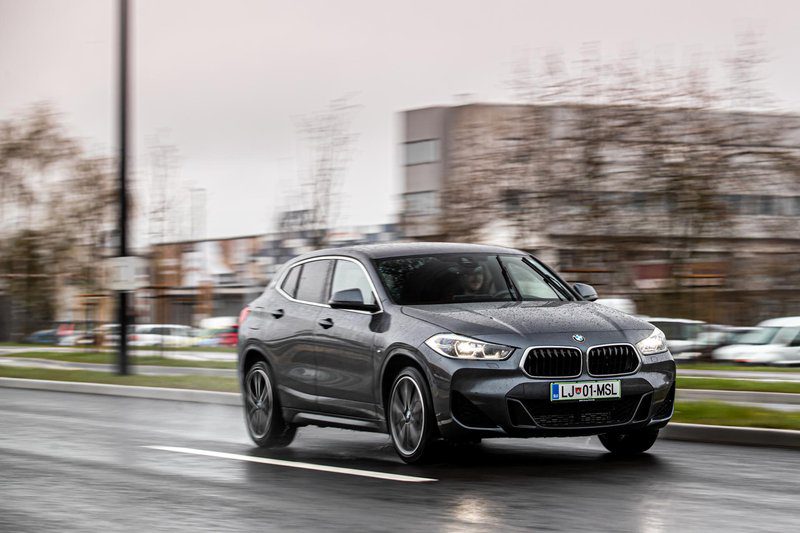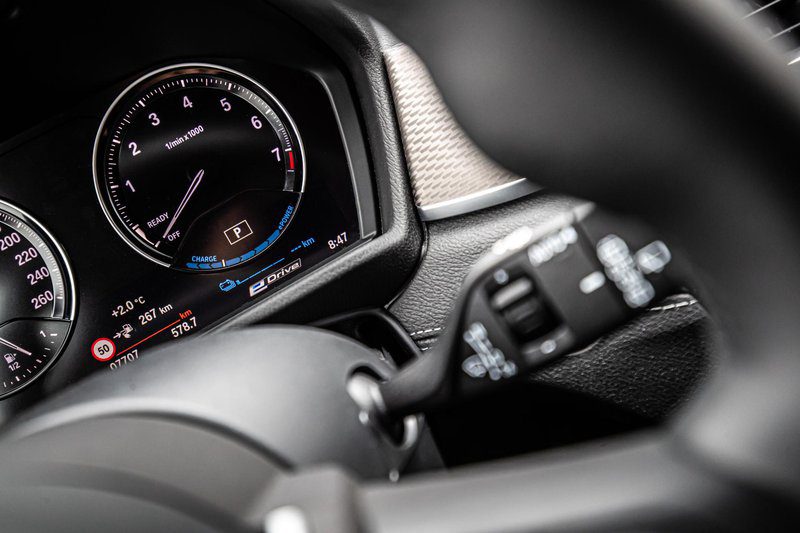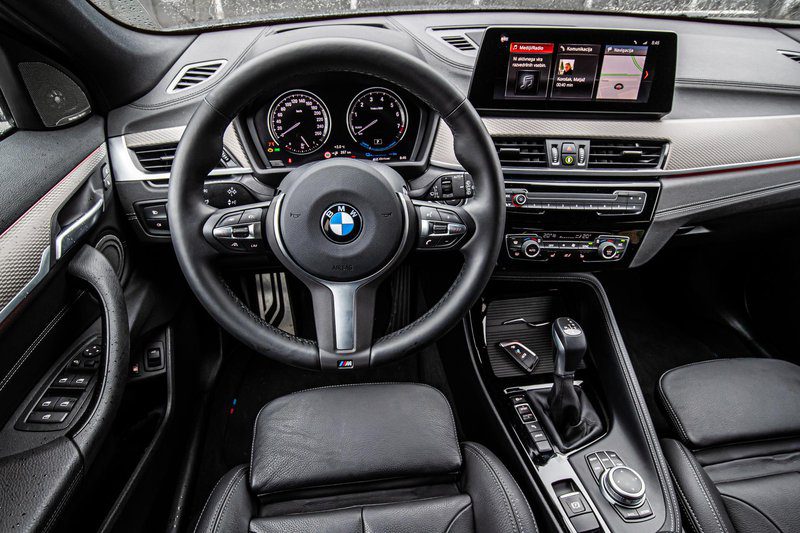
Brief test: BMW X2 xDrive 25e // X Faktor
While candidates usually only have one obvious talent, one X Factor, the smallest BMW member of the X X2 family has more, as the number on his behalf suggests. Especially in the version that was the last in our test park, and the full designation of which reads: xDrive25e.
These characteristics strengthened BMW's lineup in January of this year, and even then, I briefly acquired the same car that my company has now. This is a good thing, of course, as I wrote at the time that due to a short test drive, I was not able to test the drivetrain the way it should be.
What does the xDrive 25e tag actually mean? It is a combination of a 1,5-liter turbocharged petrol engine producing 92 kilowatts (125 "horsepower") and a 70 kilowatt electric motor.... The two outputs add up to 162 kilowatts, which BMW also calls the system power of the transmission. In any case, this is enough for drivers who want a slightly more dynamic ride, as befits a car under the Bavarian flag. Well, about how the X2 behaves on the road, a little later.

What do I imagine a traditional BMW fan from the mid-XNUMX's, how his nose is blowing his nose due to the fact that BMW started using three-cylinder engines.... But the reality is, last but not least, their i8 sports car, the pioneer of the hybrid era at BMW, also had one under the hood; its engine, in principle, differed little from the test one, as well as from its predecessor.
In addition, said engine hides a small number of cylinders in practice. The cab of the car is extremely well soundproofed, so the recognizable hum of such engines can only be seen at speeds above 3.000 rpm. But lest I go too far in describing the gasoline nature of the car - not least thanks to only the 36-liter tank and nothing modest consumption, and you won't go far with only gasoline -, so I'd rather focus on the first X factor, the interaction between the electric motor and the gasoline engine.
The X25e can run exclusively on gasoline, electricity or hybrid, that is, with both drives at the same time. Driving exclusively on petrol results in a lot of fuel consumption and little autonomy, but I also didn't start very far off purely on electricity. The 50-kilometer autonomy mentioned by the manufacturer is completely utopian or achievable only in the most ideal conditions. It should be added that the electric motor starts the car if the driver so decides, and the battery allows it, even up to a maximum speed of 135 kilometers per hour, and also allows a decisive overtaking; the petrol engine only intervenes when accelerating after a few seconds of uncompromising pressing of the right foot on the car's ground.

So it's all about the flow rate and the small, ahem, fuel tanks. Or what? The secret to optimal consumption of gasoline or electricity lies in the intelligent (joint) use of both kits, which was best shown in our test diagram. While driving along the highway, I ordered the car to use only the gasoline engine, and along the way I also charged the electric motor. Not very intensively, but the distance between Vodice and the export in Stozice has increased by about two to three kilometers. On the other hand, I managed to drive kilometers outside the city and outside the city mainly on electricity, and many thanks for this empty road and an efficient energy recovery system.
So the battery is completely discharged only after a good 90 kilometers, and even after that the car is at every acceleration if it only managed to catch a watt of electricity during the last braking., because of the driving program that dictated this to him, he first turned on the electric motor, only then the gasoline engine joined him. End result: the costs for a normal round were quite decent, 4,1 liters of fuel per 100 kilometersmuch less than the April BMW X1 test with the same powertrain, which ran at much lower temperatures and on wet roads, and the car is slightly larger.
So the X2 can be economical, but it can also be very dynamic. This X2 features a custom suspension, coil springs and three-spoke cross rails at the front and multi-rail and spring axles at the rear. So despite the M package, there is no adjustable suspension here, but I must admit I didn't even miss it. Despite the heavy weight of the car (up to 1.730 kilograms!), The X2 is an above average driveable car for this class with minimal body tilt. Several times I even thought that I was going for 1 episode, which is not so unusual at a height of a good one and a half meters. The stiffer suspension certainly causes more noise on bad roads, but it's just a trade-off that takes some getting used to.... On the other hand, I was much more worried about an overly straight steering wheel with a sudden feeling that also did not give the best information about what was going on under the front wheels.

The last trump card of the test car is the feeling in the cabin. The electrically adjustable seats allow me to adjust the position in almost all directions, as well as inflate the side airbags, making me feel chained to the seat. – which is definitely great. The dashboard, dash and projection screen are traditionally transparent, as is the infotainment system. I confess, I'm not a fan of touchscreens, but I was so used to BMW iDrive solutions a while ago that even a quick glance at the center LCD was enough to access a separate submenu.-screen, and everything else was done intuitively with the right hand.
However, the interior is not perfect. It's mostly a high price tag for the right materials, but the plastic strip on the dashboard is a concern - not only because of the material, but also because of the bad fit of the dashboard. At the same time, the wireless charger hidden in the central armrest can only be used conditionally. If your smartphone is over six inches tall, you can forget about it.
However, the X2 xDrive 25e has a lot of factors, but it also impresses more affluent customers because of its price tag. Because the price is not cheap at all, especially because of the plug-in hybrid drive. Is it worth another 1.000 euros? After testing the X1, I was still a little skeptical about this, but now it seems to me that with its little brother, such a drive is definitely a smart choice.
BMW BMW X2 xDrive 25e xDrive 25e
Basic data
| Sales: | BMW GROUP Slovenia |
|---|---|
| Test model cost: | 63.207 € |
| Base model price with discounts: | 48.150 € |
| Test model price discount: | 63.207 € |
| Power: | 162kW (220 KM) |
| Acceleration (0-100 km / h): | 6,8 with |
| Maximum speed: | 195 km / h |
| Mixed flow ECE: | 1,7-1,8l / 100km |
Costs (per year)
Technical information
| engine: | Engine: 3-cylinder - 4-stroke - in-line - petrol - displacement 1.499 cm3 - maximum power 92 kW (125 hp) at 5.000-5.500 - maximum torque 220 Nm at 1.500-3.800 rpm. Electric motor: maximum power 70 kW - maximum torque 165 Nm. System: Maximum power 162 kW (220 PS), maximum torque 385 Nm. |
|---|---|
| Battery: | Li-ion, 10,0 kWh |
| Energy transfer: | engines are driven by all four wheels - 6-speed automatic transmission. |
| Capacity: | top speed 195 km/h - acceleration 0-100 km/h 6,8 s - top electric speed 135 km/h - average combined fuel consumption (WLTP) 1,8-1,7 l/100 km, CO2 emissions 42–38 g/km – electric range (WLTP) 51–53 km, battery charging time 3,2 h (3,7 kW / 16 A / 230 V) |
| Mass: | empty vehicle 1.585 kg - permissible gross weight 2.180 kg. |
| External dimensions: | length 4.360 mm - width 1.824 mm - height 1.526 mm - wheelbase 2.670 mm - boot 410–1.355 l. |
| Box: | 410-1.355 liters |
We praise and reproach
consumption
efficient driving programs
driving position
price
no blind spot detection system
too small / unusable space for wireless charging of the smartphone